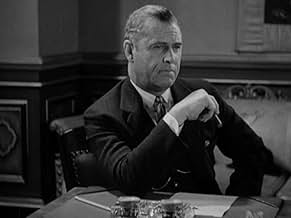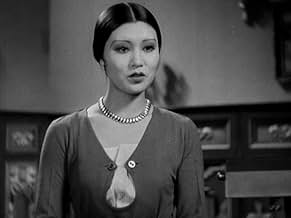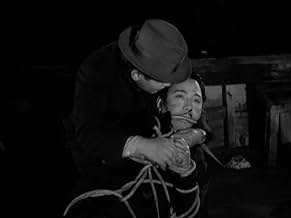Agrega una trama en tu idiomaA hatchet man is ordered to kill his close friend for the sake of Tong.A hatchet man is ordered to kill his close friend for the sake of Tong.A hatchet man is ordered to kill his close friend for the sake of Tong.
- Dirección
- Guionistas
- Elenco
- Premios
- 2 premios ganados en total
J. Carrol Naish
- Sun Yat Ming
- (as J. Carroll Naish)
Edward Peil Sr.
- Bing Foo
- (as Eddie Piel)
Anna Chang
- Sing Girl
- (sin créditos)
Blanche Friderici
- Madame Si-Si
- (sin créditos)
Willie Fung
- Notary Fung Loo
- (sin créditos)
- …
Anne Howard
- Young Girl
- (sin créditos)
Ralph Ince
- 'Big Jim' Malone
- (sin créditos)
Otto Lederer
- Pawnbroker
- (sin créditos)
James B. Leong
- Tong Member
- (sin créditos)
Gladys Lloyd
- Fan Yi
- (sin créditos)
- Dirección
- Guionistas
- Todo el elenco y el equipo
- Producción, taquilla y más en IMDbPro
Opiniones destacadas
I'm not a fan of yellow face for reasons that should be obvious, that said, I've seen a lot better. Except for Edward G. Robinson, most of the yellow face here is terrible, as is the characterization. If a bunch of white people are going to act as Chinese, they could at least make it more authentic. Almost any other actor starred in this, I would have given this a 3 or a 2.
But I recognize the near unmatched quality of Edward G. Robinson's film, who solely carries the film, and makes it watchable. Whether he's a deadly murderer, or on top of the Chinese world, or cheated on by his wife, or working lowly in the fields, or retrieving said wife from a person she was sold to... Edward G. Robinson's acting, especially physical, brings so much weight and life to the character, in his case only, I can honestly forget for a time that it;'s a yellow face character.
But I recognize the near unmatched quality of Edward G. Robinson's film, who solely carries the film, and makes it watchable. Whether he's a deadly murderer, or on top of the Chinese world, or cheated on by his wife, or working lowly in the fields, or retrieving said wife from a person she was sold to... Edward G. Robinson's acting, especially physical, brings so much weight and life to the character, in his case only, I can honestly forget for a time that it;'s a yellow face character.
Portraying such a different world to what we know makes this a little difficult to relate to but the use of familiar actors helps. This feels a little restrained and sedate for William Wellman film but nevertheless it squeezes a lot in, keeps your interest and is a certainly unusual.
Edward G (G for greatly overrated) Robinson actually gives a particularly decent performance in this. Although obviously not Chinese he gives the part a surprisingly rich amount of authenticity. He plays his character very sympathetically, respectful to the Chinatown community - albeit a community he feels increasingly isolated from, so I don't see any issues with this at all.
The set designers and makeup department did wonders with this, you really feel like you're in old San Francisco's Chinatown. Whereas EGR does look pretty Chinese, Loretta Young just looks pretty. Her makeup does make her look quite weird but it would be impossible for her not to look absolutely stunning. This performance however is not one of her best. She was an outstanding actress but is wasted in this - she doesn't have much to do other than to look pretty.
But the question is: what does she see in Leslie Fenton? He looks like the most evil man in the world. That sinister smile of his has the glint of the brass plate of a coffin. So what does she see in him? That's one of the problems with this film - we're not told. One minute she's saying hello, the next minute she's having an affair with him. Important parts of the story are just ignored - it could have done with another half an hour.
Director William Wellman used Fenton to similar effect in THE PUBLIC ENEMY the year before but in that we knew who he was. Considering the opulence of the sets, it feels like all the money was spent there and nobody bothered to pay the scriptwriters. Fenton's character feels unfinished. Like Loretta Young's character, you don't really get to know him properly. Besides EGR's Mr Wong which is beautifully crafted with inner conflict with contradictions you can see fighting each other inside his head, some of the supporting actors' characters feel like caricatures.
Despite the film's premise, essentially about an assassin and despite it being made by William Well-action-man, it's surprisingly tame and not very meaty. Don't expect proto-Tarantino but do expect sensitivity and a genuine attempt to tell a story of a modern man who feels trapped in a culture he no longer belongs to.
Edward G (G for greatly overrated) Robinson actually gives a particularly decent performance in this. Although obviously not Chinese he gives the part a surprisingly rich amount of authenticity. He plays his character very sympathetically, respectful to the Chinatown community - albeit a community he feels increasingly isolated from, so I don't see any issues with this at all.
The set designers and makeup department did wonders with this, you really feel like you're in old San Francisco's Chinatown. Whereas EGR does look pretty Chinese, Loretta Young just looks pretty. Her makeup does make her look quite weird but it would be impossible for her not to look absolutely stunning. This performance however is not one of her best. She was an outstanding actress but is wasted in this - she doesn't have much to do other than to look pretty.
But the question is: what does she see in Leslie Fenton? He looks like the most evil man in the world. That sinister smile of his has the glint of the brass plate of a coffin. So what does she see in him? That's one of the problems with this film - we're not told. One minute she's saying hello, the next minute she's having an affair with him. Important parts of the story are just ignored - it could have done with another half an hour.
Director William Wellman used Fenton to similar effect in THE PUBLIC ENEMY the year before but in that we knew who he was. Considering the opulence of the sets, it feels like all the money was spent there and nobody bothered to pay the scriptwriters. Fenton's character feels unfinished. Like Loretta Young's character, you don't really get to know him properly. Besides EGR's Mr Wong which is beautifully crafted with inner conflict with contradictions you can see fighting each other inside his head, some of the supporting actors' characters feel like caricatures.
Despite the film's premise, essentially about an assassin and despite it being made by William Well-action-man, it's surprisingly tame and not very meaty. Don't expect proto-Tarantino but do expect sensitivity and a genuine attempt to tell a story of a modern man who feels trapped in a culture he no longer belongs to.
Naturally, the casting of Caucasian actors in Asian roles (see also "The Good Earth," "Dragon Seed," Charlie Chan, Mr. Moto, etc.) is a thing of the past. Casting Edward G. Robinson as a Chinese hit man is equivalent to doing a revival of "Flower Drum Song" with Hugh Jackman and Britney Spears. However, the plot of "The Hatchet Man" is well-thought out and surprisingly respectful of Chinese culture in America. Okay, they're killing each other, but is that any worse than, say, "The Godfather" series as relates to Italian-American culture? At least that don't have the Chinese characters saying things like, "Oh, me velly solly." Plus, the ending (which I won't spoil) is absolutely right and decidedly welcome.
A hatchet job is what I fully intended to do to this movie until I found some quiet time in the afternoon to watch it. In fact I gave it an 8/10 for novelty as well as pathos. The casting is preposterous. Can you imagine Edward G Robinson and Loretta Young as Chinese?
Eddie G plays a well respected Tong assassin who is forced to kill his childhood friend and blood brother (played by J Carroll Naish) witch was no surprise. He inherits the friends business and 6 year old daughter for his effort. He prospers and when the girl grows up, he marries her. I should mention that Loretta Young was only 19 when she made this movie and she was remarkably sexy and seductive. Along comes another Tong War and Eddie is pulled out of retirement to do his stuff. Meanwhile his young wife falls for the bodyguard and runs off with him. Loretta and her lover are deported to China for messing about with opium. Although Eddie is initially shamed by her betrayal, he eventually redeems himself and his reputation. After all, he is a hatchet man!
This is one of EGR's lesser known movies, but if you can get over the bizarre casting, the story really is gripping and the cast turns in a bravo performance.
Eddie G plays a well respected Tong assassin who is forced to kill his childhood friend and blood brother (played by J Carroll Naish) witch was no surprise. He inherits the friends business and 6 year old daughter for his effort. He prospers and when the girl grows up, he marries her. I should mention that Loretta Young was only 19 when she made this movie and she was remarkably sexy and seductive. Along comes another Tong War and Eddie is pulled out of retirement to do his stuff. Meanwhile his young wife falls for the bodyguard and runs off with him. Loretta and her lover are deported to China for messing about with opium. Although Eddie is initially shamed by her betrayal, he eventually redeems himself and his reputation. After all, he is a hatchet man!
This is one of EGR's lesser known movies, but if you can get over the bizarre casting, the story really is gripping and the cast turns in a bravo performance.
The Hatchet Man (1932)
So burdened with ethnic slandering—most of it "unintentional" at least—this movie is almost impossible to watch fairly. The basic story of inter-clan fighting and murder in the Chinese community (in San Francisco) is meant no doubt to have echoes in Italian mobster killings, and therefore have a wider appeal. But when the main characters are played by very non-Chinese talents (a product of the prejudice in Hollywood at the time), there is a constant woe and disbelief on many levels.
Of course, these problems are exactly why a "student' of early Hollywood should watch this. This is a way to get some sense of the problem these movies present. And there are additional reasons to see this—mainly the two really famous actors of the period doing their best to be Chinese. Edward G. Robinson is of course one of the greats of the era, an odd but searingly talented actor, and he plays well the head of one of the Chinese clans (or tongs). His wife has a smaller role but important —and so Loretta Young, a rising, fresh star, does what she can.
Nothing can redeem all this. The title refers to the violence of the subculture, where the solution for dishonor is death (by hatchet, literally).
There is the simplest of attempts to show how the Chinese were assimilating at the time. In a way the movie shows some shred of real life for the Chinatowns of America. The secondary theme here is love, and a kind of arranged marriage. This conflicts in different ways and Robinson, playing a Westernized immigrant, faces one aspect of this New World he can't quite understand. There are a couple of turns of plot to keep you alert, and a crazy ending worth seeing.
It's great to see Warner Archive put this out there in a clean copy, ready for all our various social biases. Maybe that's why it's worth it on some level. Never mind that it is often stiff and slow. Judge it as you can.
So burdened with ethnic slandering—most of it "unintentional" at least—this movie is almost impossible to watch fairly. The basic story of inter-clan fighting and murder in the Chinese community (in San Francisco) is meant no doubt to have echoes in Italian mobster killings, and therefore have a wider appeal. But when the main characters are played by very non-Chinese talents (a product of the prejudice in Hollywood at the time), there is a constant woe and disbelief on many levels.
Of course, these problems are exactly why a "student' of early Hollywood should watch this. This is a way to get some sense of the problem these movies present. And there are additional reasons to see this—mainly the two really famous actors of the period doing their best to be Chinese. Edward G. Robinson is of course one of the greats of the era, an odd but searingly talented actor, and he plays well the head of one of the Chinese clans (or tongs). His wife has a smaller role but important —and so Loretta Young, a rising, fresh star, does what she can.
Nothing can redeem all this. The title refers to the violence of the subculture, where the solution for dishonor is death (by hatchet, literally).
There is the simplest of attempts to show how the Chinese were assimilating at the time. In a way the movie shows some shred of real life for the Chinatowns of America. The secondary theme here is love, and a kind of arranged marriage. This conflicts in different ways and Robinson, playing a Westernized immigrant, faces one aspect of this New World he can't quite understand. There are a couple of turns of plot to keep you alert, and a crazy ending worth seeing.
It's great to see Warner Archive put this out there in a clean copy, ready for all our various social biases. Maybe that's why it's worth it on some level. Never mind that it is often stiff and slow. Judge it as you can.
¿Sabías que…?
- TriviaEdward G. Robinson's wife at the time, Gladys Lloyd, appears uncredited as "Fan Yi". They were married from 1927 to 1956 and she would appear in five films with him from 1931-32.
- ErroresWhen Wong Low Get displays the scar on his left arm to the Tong; he places his right arm palm down over his left and pulls back the sleeve. But on the next immediate cut which is a close-up of the arm; he now has his right arm palm up under the left arm.
- Citas
Wong Low Get: Sometimes it is better that the eye should not see what the hand is doing.
- ConexionesEdited into El jade fatal (1939)
Selecciones populares
Inicia sesión para calificar y agrega a la lista de videos para obtener recomendaciones personalizadas
- How long is The Hatchet Man?Con tecnología de Alexa
Detalles
- Tiempo de ejecución1 hora 14 minutos
- Color
- Mezcla de sonido
- Relación de aspecto
- 1.37 : 1
Contribuir a esta página
Sugiere una edición o agrega el contenido que falta

Principales brechas de datos
By what name was The Hatchet Man (1932) officially released in Canada in English?
Responda






















